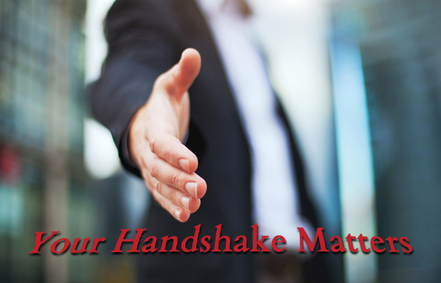Everyone loves the sound of their name. In fact, studies show that hearing one's name spoken actually activates the brain, even when the name is spoken aloud in a noisy room. Calling someone by their name is one of the easiest ways to make someone feel acknowledged, special and valued and yet so many people begin a first meeting with “I apologize; I am so terrible at remembering names…”
|
Remembering names is one of the most difficult and yet one of the most memorable things you can do. Remembering someone’s name and the correct pronunciation of it in a face to face encounter can set you apart immediately. William Shakespeare said: “There is no sound so sweet as the sound of one’s own name” and he was oh so right.
Everyone loves the sound of their name. In fact, studies show that hearing one's name spoken actually activates the brain, even when the name is spoken aloud in a noisy room. Calling someone by their name is one of the easiest ways to make someone feel acknowledged, special and valued and yet so many people begin a first meeting with “I apologize; I am so terrible at remembering names…”
1 Comment
Last week I talked about the importance of a good handshake. This week I would like to continue to address the handshake and some concerns around it. A family member, who is also a doctor, gave me a copy of his JAMA (Journal of the American Medical Association) newsletter. One of the articles he wanted me to see was all about the handshake and the significant role it plays in transmitting disease.
First, let’s take a look at this social custom which is ingrained in so many, but by no means all, cultures. It is believed that the handshake started as a gesture of goodwill with the Greeks—revealing one’s open palm conveyed trust and the fact that no weapon was hidden. This open palm gesture evolved over time to what we see today as the handshake. It is used for greetings, to show respect, congratulations, used when departing one’s company, used to solidify formal agreements and more. There was a time when a person’s word and their handshake was all that was needed to seal a deal. While there may be many other forms of greeting around the world, in the world of business the handshake is still primarily the gesture that binds the agreement. I don’t know why I am continually amazed when I get a bad handshake. While there are countries in the world where a handshake is not appropriate, in the vast majority of the world it is the accepted form of greeting someone. In the business world, it is not only the accepted form of greeting but it is also used to close a deal or to say goodbye.
We’ve all heard that it takes only 7 seconds to make an image impact, but it may be far less than that according to a series of experiments done by Princeton psychologists, Janine Willis and Alexander Todorov. According to their findings, it only takes 1/10th of a second to form an impression about someone and those impressions are not significantly altered. If this is true, your handshake becomes even more important than ever. We hear a lot about how our Words make up only 7% of our message. We hear that it is not so much about what we say as how we say it. In acting, we tell people learning a script to set the intention before they say the words. By setting the intention, you know what the character was trying to convey when they spoke the words. Unfortunately in our day to day interactions we often speak without thinking or speak with the wrong intentions. “What you do speaks so loudly that I cannot hear what you say.” You can learn how to stand, gesture, use body language, how to dress appropriately, shake hands correctly, mix and mingle but at the end of the day your words will not cover for you. Our word choices carry power. We can look the part, but if we don’t sound the part, we are not going to get the job, the raise, the advancement etc. You see our words may only be 7% of the message, but they are a stronger 7% than you might imagine.
In the speaking business, there’s a lot of controversy over whether or not a person should use notes. Some trainers tell their students that using notes makes them appear less sure of their material and not as confident. While I disagree with this philosophy, I must admit that all too often I see people use notes incorrectly. They are either so focused on their notes they forget to have a conversation with their audience, they’re using their PowerPoint as their notes or they have succumbed to the notion of no notes at all. In fact, one of the most common questions we get in our workshops is “How do you feel about using notes?” Our response is always the same—notes are fine as long as you use them properly. There are, however, some guidelines for using notes and once you know them you’ll actually be in greater control of the material you’re delivering and as a consequence you’ll appear more confident. So let’s get down to the business of notes.
Let’s first talk about what not to do. Whether you call it manners, etiquette or common consideration for your fellow human beings, it appears it needs to be reinforced in today’s business environment. We hear so much about how to conduct ourselves in business and yet we don’t realize that our actions are speaking louder than our words when it comes to how we conduct ourselves with others. We have become so tied to our cell phones, tablets and computers that they have literally become the focal point of our world—at times appearing more important than the people we are physically with or around.
The trend toward a more casual lifestyle has permeated every aspect of our lives. And yet, over the last decade we’ve watched the pendulum swing from a more casual dress code replacing the more traditional office suit to the resurgence of the more traditional dress code. It seems that many employees forgot the “business” in business casual. As such we’ve witnessed a huge misuse of what constitutes “casual” in the workplace. We’ve watched the boundaries between work and play, erode. Initially many employers believed that a more casual dress policy would promote greater morale, better communication, greater company loyalty and increased productivity. What was not taken into consideration was that employees might mistake casual for a less than professional look and ultimately have a negative impact on the company’s brand.
What exactly defines casual in the workplace? How do we dress casually and still continue to look professional? These are the questions that need to be asked and answered if one hopes to get that high profile job and or climb the corporate ladder. Let’s start with first things first. If you have not done so already, make sure you get a copy of your company’s dress code. I was working for a company that contracted me to present a two-day workshop for a very large national corporation. Half way through the program one of the Vice President’s came up to me and asked if I would please address proper “business casual” attire. She said that one of the big problems they were having now that it was summer was too many women wearing open toed shoes and sandals and it was strictly against company policy. The first rule when it comes to “business casual” is to know your company’s dress code. If your company has the dress code printed up they are usually very happy to share a copy with you. Make sure you request one. Dress codes will differ from one company to another and from one region to the next. They may even vary among different departments within one company, depending on the amount of direct communication that each department has with clients. For example, what’s appropriate in the art department may differ from what works for the sales department. To determine how you personally should dress “business casual” examine the type of company for which you work. Is it a store, a bank, an insurance company? What’s your role in the company? Do you work at a computer all day or are you frequently out making sales calls? Are you a boss or an assistant? What kind of day do you have planned? These are all factors that will greatly influence what you wear. Make sure your outfit is appropriate for the occasion. If your company has an extremely casual dress code but you will be calling on customers all day, find out what the dress code is for each company you will be calling on and then wear an outfit that will be appropriate for the company with the most rigid dress code. You can always take off a tie or jacket as long as you have one with you. Men make fewer mistakes when it comes to business casual because they have fewer options to choose from. But even though your company may have a very relaxed dress code, there are still some big no-nos to keep in mind. Ladies and gentlemen do not wear:
Ladies do not wear:
Gentlemen do not wear:
Now that you know what to avoid, let’s discuss some casual staples you should have, especially if you plan to move up the corporate ladder. We live in an age of lifelong learning. Even those who have had a successful career up to this point can’t afford to tread water. Wise business upstarts, as well as more seasoned managers and executives, are willing to move out of their comfort zones – to learn new principles and concepts, experiment with new skills and practice what they learned until it becomes automatic. To maintain a successful career professional athletes know to gain expertise through training, and never, ever stop learning. As Satchel Paige once said, “Never look back; someone might be gainin’ on you.”
Thinking that one “knows it all” and that there is nothing more to learn is the quickest way to get ignored when choice assignments are handed out, or passed over for a promotion. The following questions and answers can help business people prepare themselves for their next step, regardless of where they are in their career. Q. What further training is beneficial for improving the chances of being in a leadership role? A. Formal education is only the beginning. In fact, the skills needed for leadership are often overlooked in the frantic quest for a business degree. Despite years of education, many people entering the workforce today lack the abilities to adapt to a corporate culture. They often lack in the ability to see the big picture, skillfully present themselves and their ideas to others, communicate effectively and diffuse conflict when it occurs. In addition to these skills, they need to know the “how-to’s” of business etiquette and social dining. And, most importantly they need to know how to make decisions that go beyond their own best interest and are of benefit to their organization. Q. Can additional training really help someone advance? A. If an individual is committed to lifelong learning and is willing to put in the time and effort, the skills of leadership can be learned and, in time, mastered. No matter what innate abilities people have, they can gain new insights and grow in exciting new ways. These new skills and insights get employees noticed anew by supervisors, managers and colleagues. The result is that they are reevaluated on the strength of their newfound abilities. This leads to more challenging projects, enhanced visibility and an upward spiral of recognition within the organization. Q. What about senior executives with time constraints and more unique needs, how can they meet on-going learning goals? A. Time is a premium for most executives. At the same time, it’s difficult for people at that level to get the feedback they need. In some cases, major failings have been known to damage an otherwise sterling career. In situations like this, personal executive coaches can provide a great service. They can be objective, offer advice/instruction and adapt to the demanding schedule of the executive. Most employers are very supportive when they discover employees who are willing to put in the time and effort to develop their leadership skills. They know that employees who gain additional knowledge and skills are more highly motivated producers and are more likely to remain with the company. Lifelong learning is a major cornerstone of confidence, one that will help any level business professional build a successful career. Debbie Darling - © 2013 – The Presentation Pros™ |
|












